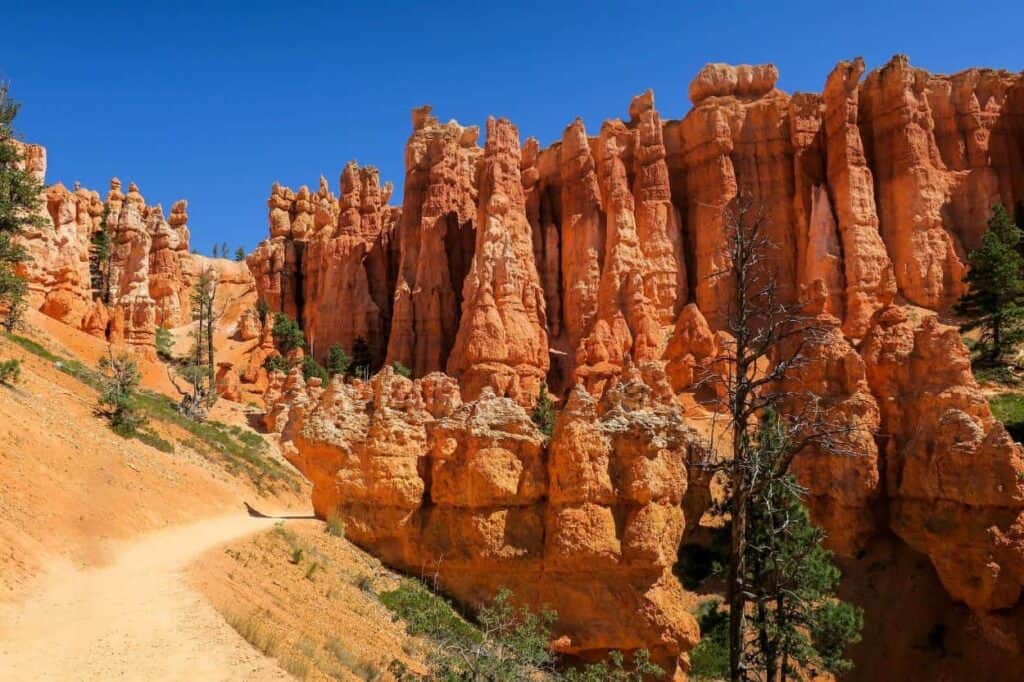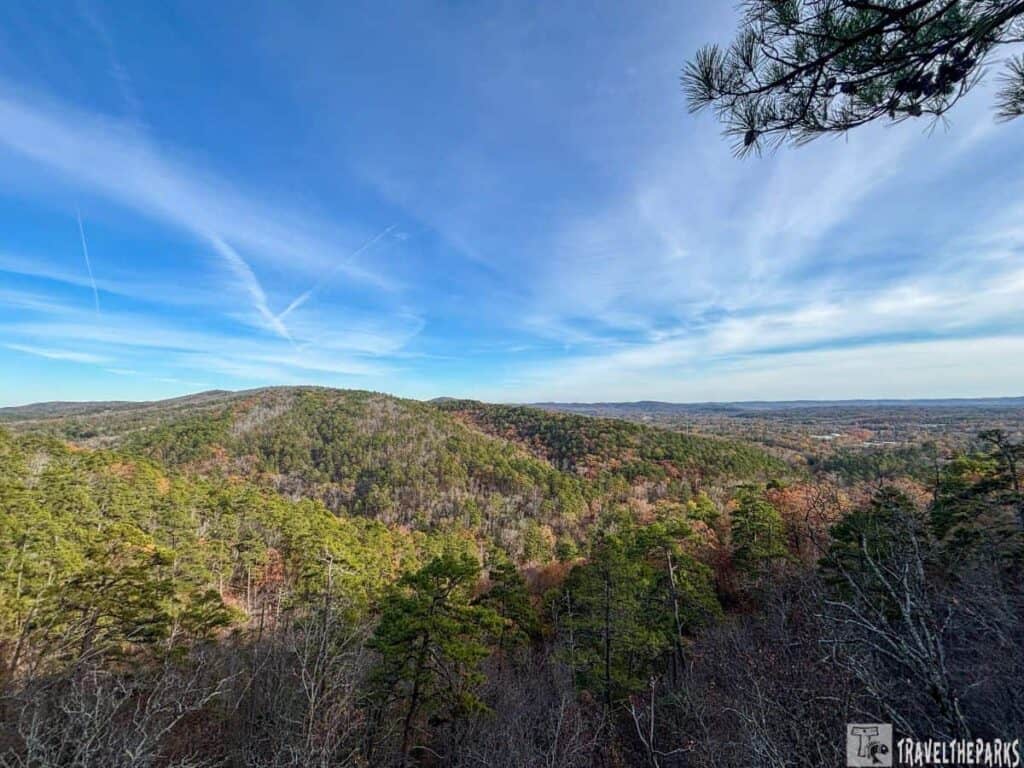“Off the Beaten Path”, Theodore Roosevelt National Park in North Dakota, is worth the journey if you are in the Midwest. There are so many ways to experience Theodore Roosevelt National Park. It comprises three distinct units – the North Unit, the South Unit, and the Elkhorn Ranch Unit – totaling 70,446 acres. Stunningly beautiful, many often underestimate Theodore Roosevelt National Park. We think this place is absolutely magical-a secret treasure.
This post may contain affiliate links, meaning if you purchase something through one of these links, we may earn a small commission at no extra cost to you! Read the full disclosure policy here.

Table of Contents
Finding Your Way to This Underrated National Park
It takes about 4 hours without stopping to drive 230 miles via Rt 85 From Rapid City, South Dakota. The drive is through endless verdant green prairie. We suggest you plan a few stops along the way for fuel, food, and restroom breaks. There are limited services for most of the trip along Rt. 85. There are several hotels in Medora within easy reach of the South unit of the park, as well as its visitors center (I-94-Exit 24 and 27). It takes about an hour to drive from Medora to the North unit via Rt. 84.
To reach the North Unit from Interstate 94, take exit 42 and head north on US-85 toward Belfield and Watford City. Drive 51 miles on US-85 before turning left into the park on Scenic Drive.

Why History Sets Theodore Roosevelt National Park Apart
Theodore Roosevelt, the president, husband, father, roughrider soldier, hunter, and cattle rancher, came to Dakota Territory to hunt bison in 1883 at 23. Looking for adventure, he found the rugged, remote landscape of the North Badlands captivating. He purchased the Maltese Cross Cabin invested in a few head of cattle before returning to New York city. Unfortunately,on February 14, 1884, he lost both his mother and his wife. Returning in June, 1884, he moved to Elkhorn ranch to recover and take solace from this great personal tragedy, rediscover his love of nature. It was here that he developed his passion and desire to conserve and protect this great land. During his presidency, he designated over 230 million acres of national parks, forests, monument and wildlife reserves.

How Time and Erosion Shaped the Badlands of Theodore Roosevelt National Park
There are many opportunities to explore and learn about the geological features and landscapes throughout the park. The rugged landscape of the Badlands was first named by the Lakota. They called this land “mako sica” mean “badlands.” Some of the strange landforms are the result of eons of weathering and erosion. 65 million years ago, the land here was a swampy inland sea. Deposits of sedimentary layers from sand and mud were later added by volcanic ash from miles away. The Little Missouri river carved a path through the softer sediments, creating the stunning ridges and valleys. These layers of siltstone, claystone, sandstone, and lignite coal give the park its stunning colors. Petrified wood is widespread. Capstones on hoodoos are common along trails, especially the Caprock Coulee Nature Trail. Clinker and the concoctions are other interesting formations.

When is the Best Time to Visit Theodore Roosevelt National Park?
During the summer and early fall are the best times to visit. It was not crowded when we went in early June, and the weather/temperature outside was very pleasant. Additionally, the rangers offer interpretive talks, hikes, and evening programs throughout the summer, if that is of interest to you. Snowfall and icy conditions can cause some of the park roads to close from November through April.
While most campgrounds are open year-round, those with flush toilets and running water are open between May and September.
Entrance into the park is $30 for a 7-day pass, or purchase the America the Beautiful pass, which is $80 for an annual pass that covers entrance into all 62 national parks and hundreds more national forests and monuments.

Which Unit Is Better? Comparing the North and South Sections of Theodore Roosevelt National Park
Why not do both? Theodore Roosevelt National Park contains 3 separate areas along the Little Missouri River: South Unit, North Unit, and Elkhorn Ranch. In the North Unit, the badlands are more rugged, with views of the Little Missouri River from the ridge-tops, while in the South Unit, the badlands are more spread out over the grasslands of North Dakota. The Elkhorn ranch unit is an isolated area between the north and south units.
Important: The North Unit operates on Central time, while the South Unit operates on Mountain time.

Why you should visit Theodore Roosevelt National Park Visitor Centers
There are 3 Visitor’s Centers. They are in the North Unit, the Painted Canyon rest stop on I-94 and the Medora entrance of the South Unit. Open daily in summer from 9:00 AM–4:30 PM. Closed November thru May. Restrooms, gift shop, exhibits, and picnic shelters are all found in the rest area.

Your First Stop: South Unit Visitor Center in Medora
The South Unit is open year round 9:00 AM–4:30 PM closed for Thanksgiving, Christmas and New Year’s Day. Maltese Cabin self-guided tours are open year round. There are interpretive exhibits, a bookstore and a gift shop. The park theater movie, “Refuge of the American Spirit” tells the story of the park’s rich ecosystem and details of Roosevelt’s early years.

What to Know About the North Unit Visitor Center
The north unit visitor center at the park entrance is open 9:00 AM–4:30 PM in the summer, closed November thru June. Housed in a trailer, it is smaller than the south unit Visitor Center. Restrooms are next door to the center. Rangers’ desk for backcountry permits and information and a small gift shop area are inside the center. All the centers have ranger led programs during summer.

Besides being named by Theodore Roosevelt, this park has a great historical connection to the past. At the South Unit Visitor’s Center in Medora, you can see Maltese Cross Cabin, the president’s first Dakota home. We found it a few yards behind the visitor’s center. The cabin gives you a rare glimpse into Roosevelt’s early life. The cabin was relocated here from its original location 7-miles away. Roosevelt credited his experiences in the badlands influencing his choice to run for president.
The Little Missouri National Grasslands surrounds the park. At 1.03 million acres, it is the largest grassland in the U.S. The unspoiled, remote terrain is ideal for camping and outdoor activities.

Hidden treasures of Theodore Roosevelt National Park: South Unit
Although both North and South units have loop roads that provide amazing opportunities to see and view wildlife, the southern unit is the largest and most visited. It’s conveniently just off I-94 near the town of Medora. Medora offers accommodations, entertainment and shopping.
The more remote North unit near Watford City does not experience the same traffic as the southern unit.

1. Don’t Miss Sunrise or Sunset at Painted Canyon Overlook
We spent the morning exploring this section of the south unit, stopping to watch an awe-inspiring sunrise from the Painted Canyon Overlook. From the visitor center you can hike into painted canyon, taking either the 1-mile nature loop or the longer 4-mile out and back trail. We preferred the shorter 30-minute trail given the overcast skies.

If you are looking to explore the red-tinted “domes” then the Painted Canyon Nature Trail is best. The 1.1-mile trail starts at the Painted Canyon Visitor’s Center rest area off I-94. The trail descends via a set of log steps into the canyon. This moderate trail was steep and narrow in some areas. We recommend a good pair of hiking boots for some of the slicker spots. Great wildlife spotting early in the morning. Lots of rabbits, bison, pronghorn and different birds species. The splash of vibrant wildflowers in the early spring and lush green grasses complimented the vivid, colorful rock layers. There are a variety of interesting geologic features on this trail.
PRO Tip: Always drink plenty of water. Take extra water along on hikes.


2. Discover the Beauty of the South Unit Scenic Road
We drove the 26-mile scenic road making stops at the different viewpoints and hiking most of the trails. Getting an early start, we avoided the crowds that seem to descend in the later hours. I much prefer to see the sunrise in most parks. The visitor center is usually our first stop, but today we hit it on the return trip because of the early hour. The scenic road covers a diverse habitat, including sagebrush flats, rocky badland buttes and rolling grasslands. There are overlooks along the road, in order:
NOTE: Because of continuous road erosion, the former scenic loop-between mile marker 24-28 is closed to all traffic, including pedestrian and bicycle access.


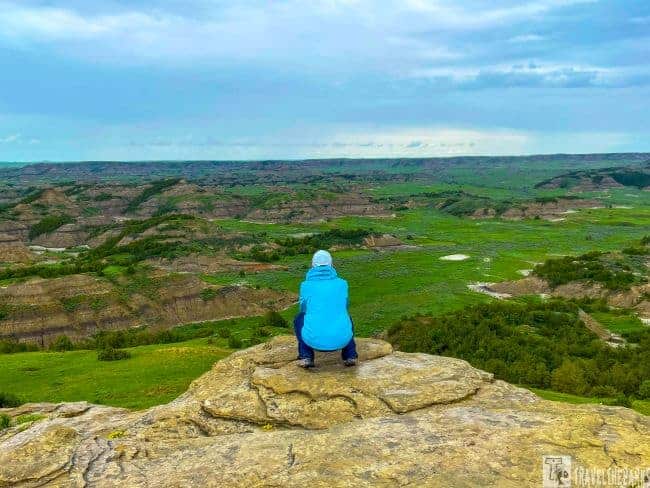

Beautiful Viewpoints Accessible via Short Walks
- Skyline Vista-0.3-mile easy paved walk along a high plateau to a vista with benches to enjoy the rolling grassland views.
- Wind Canyon Overlook-A 0.4-mile hike along a ridgeline overlooking the Little Missouri
- River, popular for sunset viewing.
- Boicourt Overlook-0.3-mile gentle gravel path atop the prairie renowned for its endless views of the South Unit’s rolling terrain.
- Buck Hill– is a 0.2 mile short, fast climb to 2,855 feet. A steep path with stairs leads to the second highest point in the park, with stunning views in all directions.
PRO Tip: When wandering off the trail, be cautious of ticks and prairie rattlesnakes, as well as prickly pear cactus.

- Coal Vein Trail-Be sure to take a brochure (available at trailhead). It provides information about the geologic processes at work in the badlands. 0.8-mile loop trail.
- Old East Entrance Trail-0.8-mile trail leads to the park’s original entrance station and goes through a prairie dog town.
- Badlands Overlook-Since the loop road is closed at Badlands Overlook, this is the turnaround point. The overlook has a panoramic look at colorful, rugged badlands spread out below.

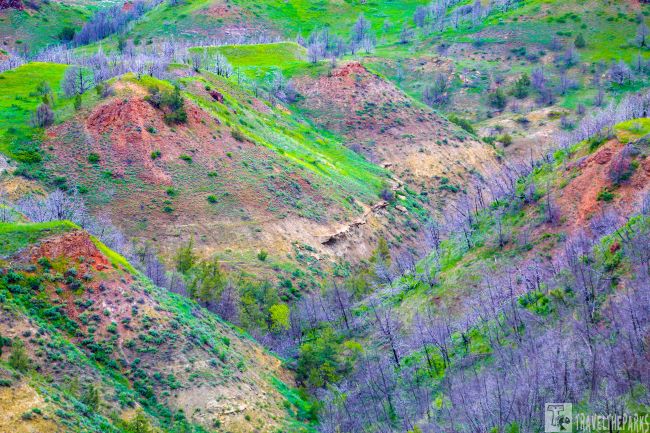
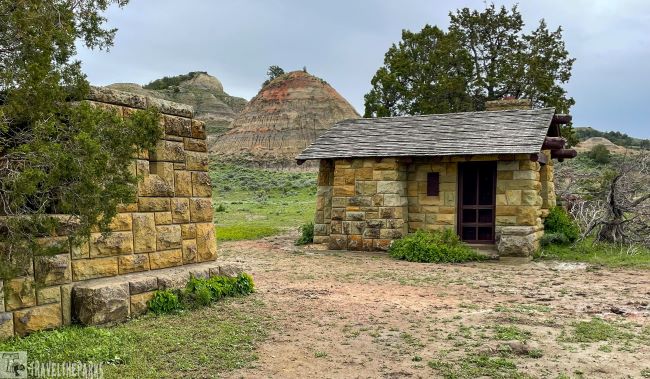
4. Hidden hiking gems in TRNP South Unit
Petrified Forest Loop-It’s a short drive outside the park on a fairly well maintained gravel road. Long trail 10.9-mile through the grasslands, however, the overcast skies are ideal for hiking today. Not much shade along the trail therefore bring plenty of water, wear a hat and apply sunscreen. The trail forks left or right 2-miles from the parking lot. Either fork will return to the main trail as part of the lollipop loop. Taking the right fork, you will see the large petrified stumps some 6-foot tall about 1.0-mile further down the path. Trekking poles are helpful in the canyon areas where the terrain is a bit rougher.

Painted Canyon Nature Trail-The trail starts adjacent to the visitor center and descends quickly into the canyon. In the early spring, wildflowers lined the trail. The moderate walk gives you a glimpse of the spectacular badlands’ geological features. Bison patties line the trail. However, today we did not see any along the trail, just a few rabbits and a deer.
Ridgeline Trail – The first 0.4-mile nature trail is relatively easy. Be sure to grab a guide at the trailhead or visitor center. In the spring, lots of wildflowers can be found along the way. The full 1.2-mile trail follows a ridgeline in Theodore Roosevelt National Park’s South Unit. A looping trail runs along the ridge’s north side. Along the way, you will find a lot of bison tracks.

5. Theodore Roosevelt National Park a best-kept secret: Wildlife Watching
Bison Sightings
Wildlife and a unique natural environment make this place a hidden treasure of beauty. I recommend bringing your binoculars! This park has loads the wildlife; from prairie dog villages, bison, wild horses, and much more. Evenings or early morning in summer are the best for seeing wildlife. From both the North and South Unit scenic roads, you will see plenty of bison. We also saw bison while on a few of our hikes. Often we had to detour off the trail twice to avoid the herds.
Remember: Respect bison. They are dangerous. Give them plenty of room.

The herds of feral horses congregated at the Cottonwood campground. At the Peaceful Valley Ranch, a few were grazing on the fresh grasses in the old fence paddocks, giving us great opportunities to photograph them. The horses are not native to the park. These herds date back to the early ranching years before the park was created.
On a walk along the Little Missouri river, we spotted deer, rabbits, and saw lots of birds. Western Meadowlarks, Eastern Towhee, American Goldfinches and Lazuli Bunting just to mention a few. Wild Turkey can often be seen in the grasslands.

Bighorn Sheep Highlight!
The most thrilling wildlife sighting for us was spotting bighorn sheep at the Oxbow Overlook in the North Unit. Just off the trail, we were able to get pretty close to them. It was really the highlight of our day in the park.

Prairie dog “towns” give visitors the opportunity to watch these inquisitive critters as they squeak and bark alerts warning the social troupe members. Many dog towns can be viewed from the road, but the best interactions are along the trails. The best viewing for us was on the trail to the old entrance, as it passes through the middle of the town. Watching the spring pups was pure joy.
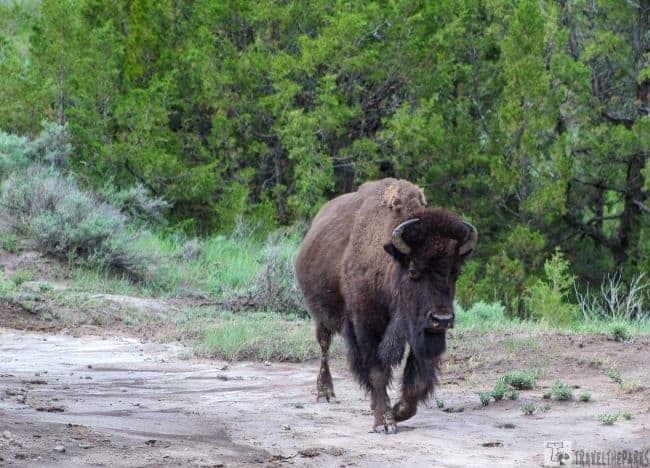
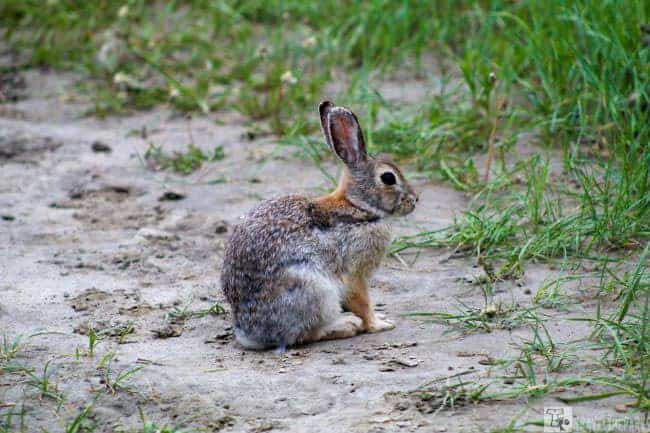


North Unit: Theodore Roosevelt National Park Off The Beaten Path
Looking for a bit more solitude? The out of the way North unit sees fewer visitors per capita. Most visitors to the park drive the scenic road out and back. Hiking trails are one of the best ways to get out and experience this section of the park. If you really want to get the most of your visit, spend a few days in the backcountry on one of the longer hiking trails. Remember to bring plenty of water on the hiking trails.

6. A Drive Along Theodore Roosevelt National Park’s North Unit Scenic Byway
The North Units main feature is the 14-mile scenic drive. The verdant green prairie was lush with the June rainfall on our visit.
- Longhorn Pullout- is the first stop, about 2-miles from the visitor center. Great location to spot the park’s free-roaming herd of longhorn steers.
- Slump Block Pullout-at mile 2.8, weathering and erosion have created a slump of the badlands cliff formation.
- Cannonball Concretions Pullout– one of the most interesting stops at mile 4.8. Found at the base of the nearby bluffs are huge spherical rock formations. River water deposits containing mineral nutrients bind sediments in the ground, resulting in these “cannonball”-shaped creations.
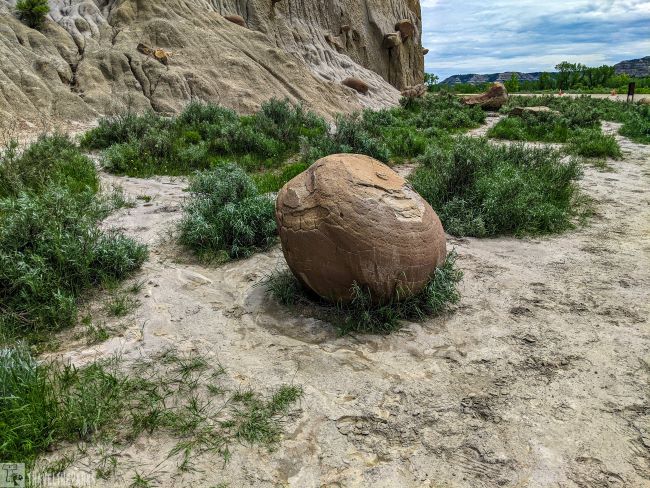
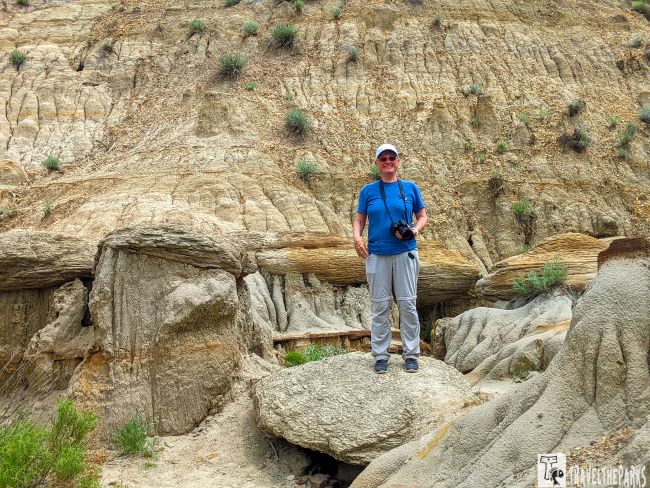
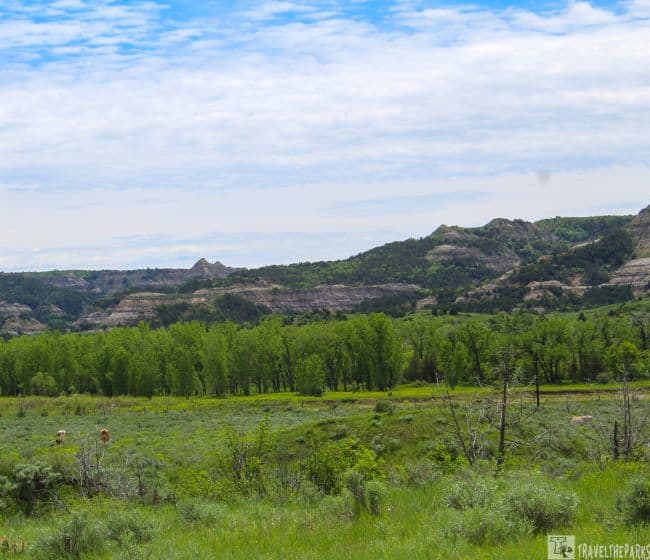
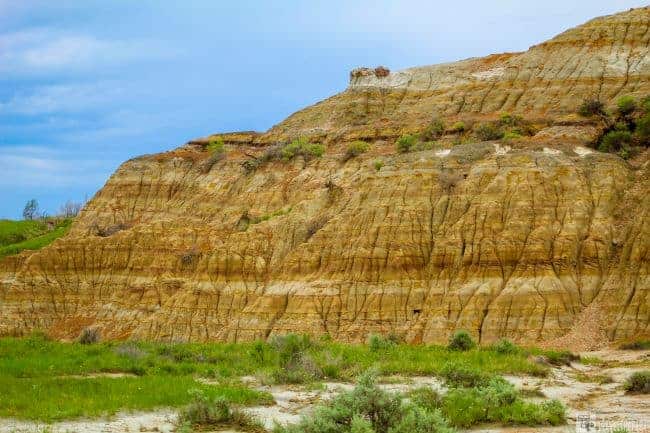
Notable Stops at the Midway Point in Theodore Roosevelt National Park: Discover This Underrated Hidden Gem
- Long X Trail– at mile 5.7 on the right is the trail used to drive cattle herds north. It crosses the Little Missouri River, headed to the prime grasslands of Squaw Creek Valley.
- River Bend Overlook at Mile 7.9 the vistas are breathtaking. A short walk to the stone shelter constructed by the Civilian Conservation Corps circa 1937. We spotted bighorn sheep on the cliff edge.
- Bentonitic Clay-The inscription at mile 9.0 reads, “The blue-black popcorn-like soil that caps the plateau 50 feet below this point is bentonitic clay. Bentonite clays flow when wet. This bluish-colored layer can be traced for miles up and down the river.”


Hidden treasures at the end of the Road
- Man and Grass Overlook- at mile 9.8 is open range grasslands preserved within the park for native wildlife to enjoy after range cattle decimated the grasses in the 1880s.
- The Edge of a Glacier Pullout-for those interests in geology of the park at mile 12.7. This field is littered with boulders called “erratics”. Apparently, the glacier moved them from Canada 400-miles north.
- Oxbow Overlook At the final overlook at the end of the scenic byway, mile-13.9 visitors can enjoy sweeping bird’s-eye views of the Badlands and an oxbow in the Little Missouri River that slices its way through the river valley.


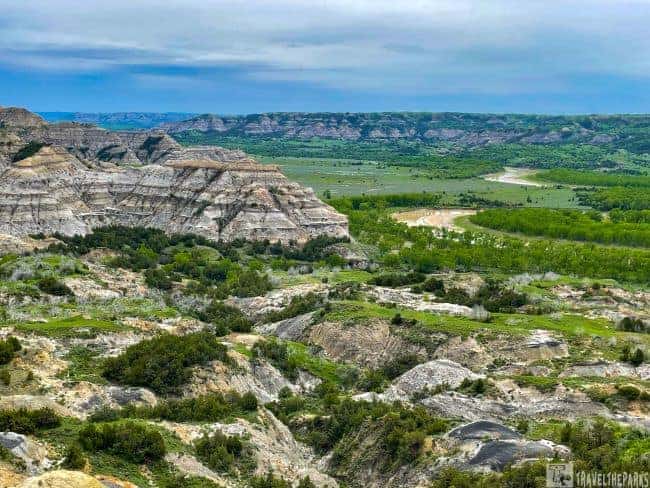
7. Hidden hiking gems in TRNP North Unit
Caprock Coulee Nature Trail Guide is a must do in the North Unit. The Caprock Coulee Nature Trail is at the beginning of this trail, which is 0.75 miles long (half way point). We found the last 0.75-miles of the trail became more challenging as it climbs up a grassy butte. This loop trail continues along a ridgeline that has spectacular views of the Little Missouri river, before descending back to the trailhead.

Sperati Point Trail-A moderate 2.4-mile out-and-back trail begins at the Oxbow Overlook. There is nothing difficult about this walk across open prairie. No bison, but plenty of bison dung. There is no doubt that Sperati Point is worth the hike in the sun for its spectacular views. Across the valley floodplain, you can see the dramatic North Dakota Badlands and a 180-degree oxbow bend of the Little Missouri River.

Buckhorn Trail-You get to explore the backcountry of the park on this awesome 11.4 mile loop trail. We only did the first 2-miles from the trailhead from the Cannonball Concretions Pullout. The trail is fairly easy to follow all the way to the prairie dog town. However, recommend long pants to avoid the ticks in the long grass. Lots of wildflowers from the spring rains. Very pretty trail.

8. Explore the Elkhorn Ranch Site: A Must-See Day Trip from Theodore Roosevelt National Park
Elkhorn Ranch is part of the national park, in between the north and south units. A 1-hour drive along rough gravel roads (it is best to inquire at the visitor center the conditions prior to driving the road). Isolated many visitors to the park do not make the journey here. We drove in from the south unit on a somewhat overcast day and had the parking lot to ourselves. The 0.75 mile trial is very well-maintained and the interpretive information was insightful. I especially enjoyed reading the quotes from Teddy Roosevelt. The cabin’s foundation stones are all that remain of Roosevelt’s ranching operation. The cabin is long gone.


The site of Teddy Roosevelt, “home ranch” during the period from 1884 to 1898, Theodore Roosevelt lived at Elkhorn Ranch in North Dakota. It is not possible to see any buildings on Elkhorn Ranch in North Dakota, but you can see bricks and foundations from where the buildings once stood.

Where to Stay Near the North Unit of Theodore Roosevelt National Park
We stayed in Belfield, ND (15 miles east) in an Airbnb rental. The small town has gas and limited groceries, lodging, and dining. The area is ideal, a short 15 minutes to Medora or to Dickinson, ND. Perfect location to visit both sides of Teddy Roosevelt National Park. It is a straight shot to the North Unit on Highway 87 (45-minutes) and only 15 minutes east of the painted canyon. If you want to be closer to amenities, Medora has hotels, Bed, & Breakfast and RV parks.

Why you should visit Theodore Roosevelt National Park Campgrounds
One of the best ways to see wildlife is to camp in the park. The south unit has Cottonwood and Roundup Group Horse Campgrounds, while the north unit has Juniper Campground.
- Cottonwood Campground is open year round. Some of the 78 sites can be reserved, some are first-come, first-served. Although there are no RV hookups, they have potable water and bathhouses with flush toilets. Reservations at www.recreation.gov.
- Juniper Campground sites overlook a bluff of the Little Missouri River. The 50 sites are considered remote with few services. All sites in Juniper are first-come, first-served.

Final Thoughts: Theodore Roosevelt National Park an Underrated Hidden Gem
Every park is unique, but this one is truly spectacular. In comparison to Badlands National Park, we liked this park better because it has more vegetation, giving it a richer palette and a more varied landscape. We fell in love with Theodore Roosevelt National Park. It is important to remember to let nature nurture you! In addition to creating a strong sense of connection with the land, spending time outdoors is often found to be therapeutic. A wilderness area can provide a calming experience, allowing the mind and soul to rejuvenate and relax. You can tap into the healing power of nature no matter where you are in life, no matter what your circumstances may be.
Have you visited Theodore Roosevelt National Park? Share your thoughts in the comments below.


